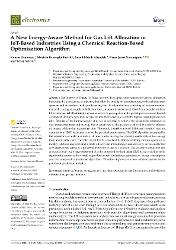| dc.contributor.author | Zanbouri, Kouros | |
| dc.contributor.author | Bastak, Mostafa Razoughi | |
| dc.contributor.author | Alizadeh, Seyed Mehdi | |
| dc.contributor.author | Navimipour, Nima Jafari | |
| dc.contributor.author | Yalcin, Senay | |
| dc.date.accessioned | 2023-10-19T15:12:03Z | |
| dc.date.available | 2023-10-19T15:12:03Z | |
| dc.date.issued | 2022 | |
| dc.identifier.issn | 2079-9292 | |
| dc.identifier.uri | https://doi.org/10.3390/electronics11223769 | |
| dc.identifier.uri | https://hdl.handle.net/20.500.12469/5328 | |
| dc.description.abstract | The Internet of Things (IoT) has recently developed opportunities for various industries, including the petrochemical industry, that allow for intelligent manufacturing with real-time management and the analysis of the produced big data. In oil production, extracting oil reduces reservoir demand, causing oil supply to fall below the economically viable level. Gas lift is a popular artificial lift system that is both efficient and cost-effective. If gas supplies in the gas lift process are not limited, a sufficient amount of gas may be injected into the reservoir to reach the highest feasible production rate. Because of the limited supply of gas, it is essential to achieve the sustainable utilization of our limited resources and manage the injection rate of the gas into each well in order to enhance oil output while reducing gas injection. This study describes a novel IoT-based chemical reaction optimization (CRO) technique to solve the gas lift allocation issue. The CRO algorithm is inspired by the interaction of molecules with each other and achieving the lowest possible state of free energy from an unstable state. The CRO algorithm has excellent flexibility, enabling various operators to modify solutions and a favorable trade-off between intensification and diversity. A reasonably fast convergence rate serves as a powerful motivator to use as a solution. The extensive simulation and computational study have presented that the proposed method using CRO based on IoT systems significantly improves the overall oil production rate and reduces gas injection, energy consumption and cost compared to traditional algorithms. Therefore, it provides a more efficient system for the petroleum production industry. | en_US |
| dc.language.iso | eng | en_US |
| dc.publisher | Mdpi | en_US |
| dc.relation.ispartof | Electronics | en_US |
| dc.rights | info:eu-repo/semantics/openAccess | en_US |
| dc.subject | Scheduling Problem | En_Us |
| dc.subject | Wells | En_Us |
| dc.subject | Constraints | En_Us |
| dc.subject | Framework | En_Us |
| dc.subject | internet of things | en_US |
| dc.subject | energy | en_US |
| dc.subject | chemical reaction optimization | en_US |
| dc.subject | gas lift allocation | en_US |
| dc.subject | multi-objective optimization | en_US |
| dc.subject | gas injection rate | en_US |
| dc.title | A New Energy-Aware Method for Gas Lift Allocation in IoT-Based Industries Using a Chemical Reaction-Based Optimization Algorithm | en_US |
| dc.type | article | en_US |
| dc.authorid | Jafari Navimipour, Nima/0000-0002-5514-5536 | |
| dc.authorid | Zanbouri, Kouros/0000-0003-0252-8282; | |
| dc.identifier.issue | 22 | en_US |
| dc.identifier.volume | 11 | en_US |
| dc.department | N/A | en_US |
| dc.identifier.wos | WOS:000887132600001 | en_US |
| dc.identifier.doi | 10.3390/electronics11223769 | en_US |
| dc.identifier.scopus | 2-s2.0-85142426626 | en_US |
| dc.institutionauthor | N/A | |
| dc.relation.publicationcategory | Makale - Uluslararası Hakemli Dergi - Kurum Öğretim Elemanı | en_US |
| dc.authorwosid | Jafari Navimipour, Nima/AAF-5662-2021 | |
| dc.authorwosid | Zanbouri, Kouros/C-5031-2019 | |
| dc.authorwosid | Nasarian, Elham/ISB-6863-2023 | |
| dc.khas | 20231019-WoS | en_US |
















